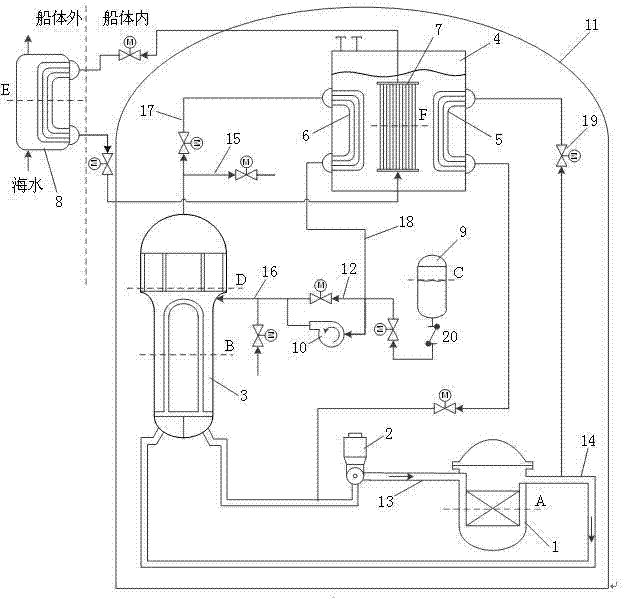Passive residual heat removal system of marine nuclear power device
A passive waste heat and waste heat discharge technology, applied in nuclear power generation, cooling devices, nuclear engineering, etc., can solve the problems of no heat, speed limit of waste heat discharge, low safety redundancy, etc., to increase safety redundancy, The effect of reducing pressure and increasing stability
- Summary
- Abstract
- Description
- Claims
- Application Information
AI Technical Summary
Problems solved by technology
Method used
Image
Examples
Embodiment 1
[0023] Such as figure 1 As shown, a passive waste heat removal system for a marine nuclear power plant includes a containment vessel 11 arranged inside the ship and a cooling heat exchanger 8 arranged outside the ship; the containment vessel 11 is provided with a reactor pressure vessel 1, Primary circuit cold pipe section 13, primary circuit heat pipe section 14, steam generator 3, refueling water tank 4, 1# waste heat discharge heat exchanger 5, 2# waste heat discharge heat exchanger 6 and cooling water in refueling water tank 4 Tube bundle 7; the refueling water tank 4 is an open box structure, which is located in the top space of the containment vessel 11. The box is equipped with deionized cooling water, 1# waste heat discharge heat exchanger 5 and 2# waste heat discharge heat exchanger 6 Both are located on the side wall of the refueling water tank 4; the inlet and outlet of the reactor pressure vessel 1 are respectively connected to the steam generator 3 through the col...
PUM
 Login to View More
Login to View More Abstract
Description
Claims
Application Information
 Login to View More
Login to View More - R&D
- Intellectual Property
- Life Sciences
- Materials
- Tech Scout
- Unparalleled Data Quality
- Higher Quality Content
- 60% Fewer Hallucinations
Browse by: Latest US Patents, China's latest patents, Technical Efficacy Thesaurus, Application Domain, Technology Topic, Popular Technical Reports.
© 2025 PatSnap. All rights reserved.Legal|Privacy policy|Modern Slavery Act Transparency Statement|Sitemap|About US| Contact US: help@patsnap.com

